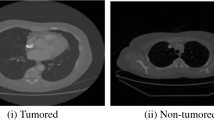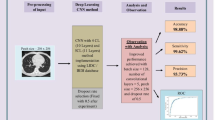Abstract
Lung cancer is one of the main reasons for death in the world among both men and women, with an impressive rate of about five million deadly cases per year. Computed Tomography (CT) scan can provide valuable information in the diagnosis of lung diseases. The main objective of this work is to detect the cancerous lung nodules from the given input lung image and to classify the lung cancer and its severity. To detect the location of the cancerous lung nodules, this work uses novel Deep learning methods. This work uses best feature extraction techniques such as Histogram of oriented Gradients (HoG), wavelet transform-based features, Local Binary Pattern (LBP), Scale Invariant Feature Transform (SIFT) and Zernike Moment. After extracting texture, geometric, volumetric and intensity features, Fuzzy Particle Swarm Optimization (FPSO) algorithm is applied for selecting the best feature. Finally, these features are classified using Deep learning. A novel FPSOCNN reduces computational complexity of CNN. An additional valuation is performed on another dataset coming from Arthi Scan Hospital which is a real-time data set. From the experimental results, it is shown that novel FPSOCNN performs better than other techniques.













Similar content being viewed by others
References
Aggarwal T, Furqan A, Kalra K (2015) Feature extraction and LDA based classification of lung nodules in chest CT scan images. IEEE, International Conference on Advances in Computing, Communications and Informatics (ICACCI), pp. 1189–1193
Akram S, Javed MY, Hussain A, Riaz F, Usman Akram M (2015) Intensity-based statistical features for classification of lungs CT scan nodules using artificial intelligence techniques. Journal of Experimental & Theoretical Artificial Intelligence 27(6):737–751. https://doi.org/10.1080/0952813X.2015.1020526
Alakwaa W, Nassef M, Badr A (2017) Lung Cancer detection and classification with 3D convolutional neural network (3D-CNN). International Journal of Advanced Computer Science and Applications (IJACSA) 8(8):409–417
Ani Brown Mary N, Dejey D (2018) ‘Classification of coral reef submarine images and videos using a novel Z with tilted Z local binary pattern (Z⊕TZLBP)’, springer. Wirel Pers Commun 98(3):2427–2459. https://doi.org/10.1007/s11277-017-4981-x
Ani Brown Mary N, Dharma D (2017) ‘Coral reef image classification employing improved LDP for feature extraction’, Elsevier. J Vis Commun Image Represent 49(C):225–242. https://doi.org/10.1016/j.jvcir.2017.09.008
Ani Brown Mary N, Dharma D (2018) A novel framework for real-time diseased coral reef image classification’, Springer. Multimed Tools Appl:1–39. https://doi.org/10.1007/s11042-018-6673-2
Bhuvaneswari BT (2015) Detection of Cancer in lung with K-NN classification using genetic algorithm’, Elsevier. Procedia Mater Sci 10:433–440
Brown A, Mary N, Dejey D (2018) ‘Classification of coral reef submarine images and videos using a novel Z with tilted Z local binary pattern (Z⊕TZLBP)’, springer. Wirel Pers Commun 98(3):2427–2459. https://doi.org/10.1007/s11277-017-4981-x
Chabat F, Yang G-Z, Hansell DM (2003) Obstructive lung diseases: texture classification for differentiation at CT1. Radiology 228(3):871–877
Chen H, Xu Y, Ma Y, Ma B (2010) Neural Network Ensemble-Based Computer-Aided Diagnosis for Differentiation of Lung Nodules on CT Images. Acad Radiol 17(5)
Da Silva GLF, da Silva Neto OP, Silva AC, de Paiva Marcelo Gattass AC (2017) “Lung nodules diagnosis based on evolutionary convolutional neural network”, springer. Multimed Tools Appl 76(18):19039–19055. https://doi.org/10.1007/s11042-017-4480-9
da Silva GLF, de Carvalho Filho AO, Silva AC, de Paiva AC, Gattass M (2016) Taxonomic indexes for differentiating malignancy of lung nodules on CT images. Research on Biomedical Engineering 32(3):263–272
de Carvalho Filho AO, Silva AC, de Paiva AC, Nunes RA, Gattass M (2016) Lung-nodule classification based on computed tomography using taxonomic diversity indexes and an SVM. Springer, Journal of Signal Processing Systems, DOI 87:179–196. https://doi.org/10.1007/s11265-016-1134-5
de Sousa Costa RW, da Silva GLF, de Carvalho Filho AO, Silva AC, de Paiva Marcelo Gattass AC (2018) “Classification of malignant and benign lung nodules using taxonomic diversity index and phylogenetic distance”, springer. Med Biol Eng Comput 56(11):2125–2136
Dhaware BU, Pise AC, (2016) Lung Cancer Detection Using Bayasein Classifier and FCM Segmentation. IEEE, International Conference on Automatic Control and Dynamic Optimization Techniques (ICACDOT), pp. 170–174
Ignatious S, Joseph R (2015) Computer Aided Lung Cancer Detection System. IEEE, Proceedings of 2015 Global Conference on Communication Technologies (GCCT 2015), pp. 555–558.
Jin X-Y, Zhang Y-C, Jin Q-L (2016) Pulmonary nodule detection based on CT images using Convolution neural network. IEEE, 9th International Symposium on Computational Intelligence and Design, pp. 202–204.
Kumar D, Wong A, Clausi DA (2015) “Lung nodule classification using deep features in CT images”, IEEE, 12th conference on computer robot vision, pp 133-138. DOI. https://doi.org/10.1109/CRV.2015.25
Li X-X, Li B, Tian L-F, Zhang L (2018) Automatic benign and malignant classification of pulmonary nodules in thoracic computed tomography based on RF algorithm. IET Image Process. https://doi.org/10.1049/iet-ipr.2016.1014
Makaju S, Prasad AA, Elchouemi S (2018) Lung Cancer detection using CT scan images. Elsevier, Procedia Computer Science 125:107–114
Nie L, Wang M, Zhang L, Yan S, Zhang B, Chua T-S (2015) Disease inference from health-related questions via sparse deep learning. IEEE Trans Knowl Data Eng 27(8):2107–2119
Nie L, Zhang L, Yang Y, Wang M, Hong R, Chua T-S (2015) Beyond doctors: future health prediction from multimedia and multimodal observations. proceedings of the 23rd ACM international conference on multimedia.
Orozco HM, Villegas OOV, Maynez LO, Sanchez VGC, de Jesus Ochoa Dominguez H (2012) Lung Nodule CLASSIFICATION in Frequency Domain Using Support Vector Machine. IEEE, In international conference on information science, signal processing and their application.
Orozco HM, Villegas OOV, Sánchez VGC, de Jesús Ochoa Domínguez H, de Jesús Nandayapa Alfaro M (2015) Automated system for lung nodules classification based on wavelet feature descriptor and support vector machine. Biomed Eng 14(9):1–20. https://doi.org/10.1186/s12938-015-0003-y
Park SC, Tan J, Wang X, Lederman D, Leader JK, Kim SH, Zheng B (2011) Computer-aided detection of early interstitial lung diseases using low-dose CT images’, Iop Publishing. Phys Med Biol 56:1139–1153. https://doi.org/10.1088/0031-9155/56/4/016
Roy TS, Sirohi N, Patle A (2015) Classification of Lung Image and Nodule Detection Using Fuzzy Inference System. IEEE, International Conference on Computing, Communication and Automation (ICCCA2015), pp. 1204–1207
Sangamithraa, Govindaraju (2016) Lung tumour detection and classification using EK-mean clustering. IEEE WiSPNET
Shao H, Cao L, Liu Y (2012) A detection approach for solitary pulmonary nodules based on CT images. IEEE, 2nd international conference on computer science and network technology.
Song QZ, Zhao L, Luo XK, Dou XC (2017) Using deep learning for classification of lung nodules on computed tomography images. Journal of healthcare engineering. https://doi.org/10.1155/2017/8314740
Sun W, Zheng B, Qian W (2016) "computer aided lung cancer diagnosis with deep learning algorithms" International Society for Optics and Photonics, medical imaging : computer-aided diagnosis. Vol. 9785
Suzuki K, Li F, Sone S, Doi K (2005) Computer-aided diagnostic scheme for distinction between benign and malignant nodules in thoracic low-dose CT by use of massive training artificial neural network. IEEE Trans Med Imaging 24(9):1138–1150
Dong-ping Tian and Nai-qian Li, 2009, ‘Fuzzy Particle Swarm Optimization Algorithm’, IEEE, International Joint Conference on Artificial Intelligence, pp. 263–267.
Van Ginneken B, Setio AAA, Jacobs C, Ciompi F (2015) Off-the-shelf convolutional neural network features for pulmonary nodule detection in computed tomography scans. IEEE 12th International Symposium on Biomedical Imaging (ISBI). doi:10.1109/isbi.2015.7163869
Zhang B, Allebach JP (2008) Adaptive Bilateral Filter for Sharpness Enhancement and Noise Removal. IEEE Trans Image Process 17(5)
Zhang L, Zhang Q, Du Member B, Huang X, Tang YY, Tao D (2016) Simultaneous spectral-spatial feature selection and extraction for Hyperspectral images. IEEE Transactions on Cybernetics
Zhang L, Zhang Q, Zhang L, Tao D, Huang X, Bo D (2014) Ensemble manifold regularized sparse low-rank approximation for multiview feature embedding”, Elsevier. Pattern Recogn. https://doi.org/10.1016/j.patcog.2014.12.016
Zhou Z-H, Jiang Y, Yang Y-B, Chen S-F (2002) Lung cancer cell identification based on artificial neural network ensembles’, Elsevier. Artif Intell Med 24:25–36
Zhu Y, Tan Y, Hua Y, Wang M, Zhang G, Zhang J (2010) Feature selection and performance evaluation of support vector machine (SVM)-based classifier for differentiating benign and malignant pulmonary nodules by computed tomography. J Digit Imaging 23(1):51–65
Author information
Authors and Affiliations
Corresponding author
Additional information
Publisher’s note
Springer Nature remains neutral with regard to jurisdictional claims in published maps and institutional affiliations.
Rights and permissions
About this article
Cite this article
Asuntha, A., Srinivasan, A. Deep learning for lung Cancer detection and classification. Multimed Tools Appl 79, 7731–7762 (2020). https://doi.org/10.1007/s11042-019-08394-3
Received:
Revised:
Accepted:
Published:
Issue Date:
DOI: https://doi.org/10.1007/s11042-019-08394-3




